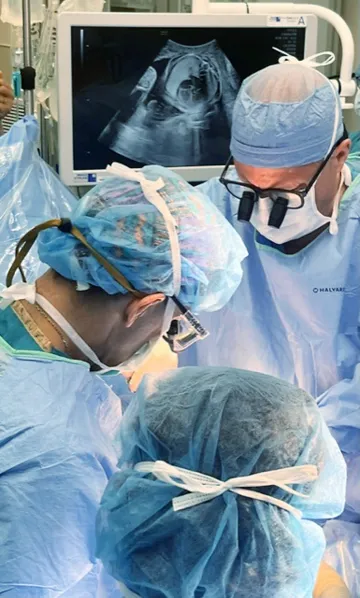Saving Ramon
A novel spina bifida surgery succeeds.

Priscila Carranza Olea and Ramon
Banner Health
With 10 weeks still to go before his birth, tiny Ramon took a short journey on the frontiers of fetal medicine. The procedure made history, and — more importantly — it worked.
Ramon briefly left his cozy home in his mother’s abdomen for a high-tech, almost incredible, surgery on his spine. Some 40 doctors and other providers took part in or observed the procedure at Banner – University Medical Center Tucson and the University of Arizona. Chief surgeon Ken Liechty said it was like conducting an orchestra.
Ramon Alberto Contreras was diagnosed with spina bifida, which creates a debilitating gap in the spine. It can make walking, breathing, speech and even cognition difficult, often requiring living with a shunt tube to drain away brain fluids.

Banner Health
But the condition can now be treated with complex surgery on the fetus, still safely in utero. The uterus is carefully lifted outside the mother for the few hours of the procedure, but the fetus remains inside its protective sac.
That had never been done in Arizona. And the team of doctors from Banner – UMC
Tucson and the U of A medical school set a new standard by creating a strong multidisciplinary team from fetal medicine, neurosurgery, nursing care and a dozen other areas. In charge was Ken Liechty, who had been recruited to Banner from the Children’s Hospital Colorado Fetal Care Center after working in fetal medicine at Children’s Hospital of Philadelphia and elsewhere.
Liechty is a fetal and pediatric surgeon and director of fetal medicine at Banner – UMC as well as surgeon-in-chief at Banner Children’s at Diamond Children’s Medical Center.
At 5:30 a.m. on Feb. 19, Liechty and his fetal medicine team gathered in Operating Room 3 in Banner’s Tower 1. They were ready at 7:30 a.m.
In the Labor and Delivery unit, Ramon’s mother was given medicines to prevent labor and transported to the operating room.
“The unusual thing is that we have two patients here.” Liechty says. “We have to think about mom and the baby.” As those in the in-utero field put it, they were “treating the patient within the patient.”
At first Ramon was in the wrong position, Liechty says. “We had to move him around, with his head down and his back up.

Ken Liechty and Anthony Avellino
Banner Health
“We made our incision to expose the uterus. It was like an orchestra that you are guiding. You have to make sure the anesthesia is doing its part. That the meds you need are working. The uterus can be very unforgiving, so you make sure it has good relaxation before you open it. And the whole time we are doing an ultrasound to monitor Ramon in utero.
“Under ultrasound guidance, we make sure the placenta and the cord are away from where we are getting into the uterus.”
Through the two-inch incision in the uterus, the team placed a tube to add a saline solution to replace the amniotic fluid in which Ramon was floating.
“Then we give him a shot to give him pain relief and make sure his heart rate stays up,” Liechty says.
Next came “the neurosurgical piece,” Liechty continues. They dropped the cord back into the spinal canal and closed the gap in the spinal column.
After two hours of surgery, Ramon was ready to be returned to his mother’s abdomen. In a few days, his mother, Priscila Carranza Olea, and her husband, Ramon Alberto Contreras Armenta, were discharged to the Ronald McDonald House for 10 weeks until Ramon’s scheduled birth.
Ramon’s surgery was a landmark for the new fetal team at the U of A and Banner – UMC Tucson.
The new faces in pediatric neurosurgery include Anthony Avellino, now director of pediatric neurosurgery at Banner.
Another key player was Truc-Anh Nguyen, a Banner fetal anesthesiologist. “That’s a unique type of anesthesia,” she says, “to put mom to sleep with a baby while we’re going to be operating on her uterus.”
‘His birth is a miracle. The baby is well, is very happy and content, as are we.’
By repairing the spine in utero, Liechty says, “That really changed the outcome for these babies, so they don’t need a tube, called a ventriculoperitoneal shunt, to drain excess fluid from the brain to the abdomen. Such a tube can get clogged. It can get infected. Patients can have complications from the placement, including bleeding in the brain.”

Banner Health
If you have spina bifida, Liechty says, your risk of needing a shunt is about 90 percent. With fetal surgery, that risk drops to about 45 percent.
For Ramon, he adds, the risk went down to about 25 percent. “That’s a dramatic impact for his life, not needing a shunt,” Liechty says.
Ramon, who was born on April 23, will be twice as likely to be able to walk independently after having the spinal defect repaired in utero, Liechty says. “Hopefully, no braces. Nothing.”
After Ramon arrived, his mother said, “His birth is a miracle. The baby is well, is very happy and content, as are we.”
As a young resident doctor, Liechty had been part of the team in the 1990s that developed the first fetal surgery at Children’s Hospital of Philadelphia. He has done more than 100 such surgeries in Colorado.
Liechty came to Arizona for “an opportunity to impact change,” he says. “That’s what drives me in medicine.”
